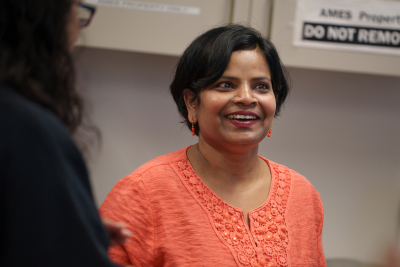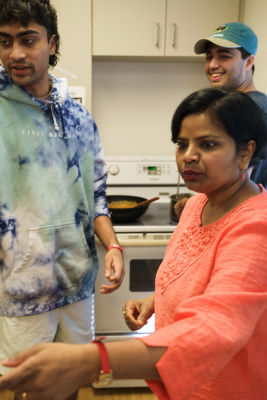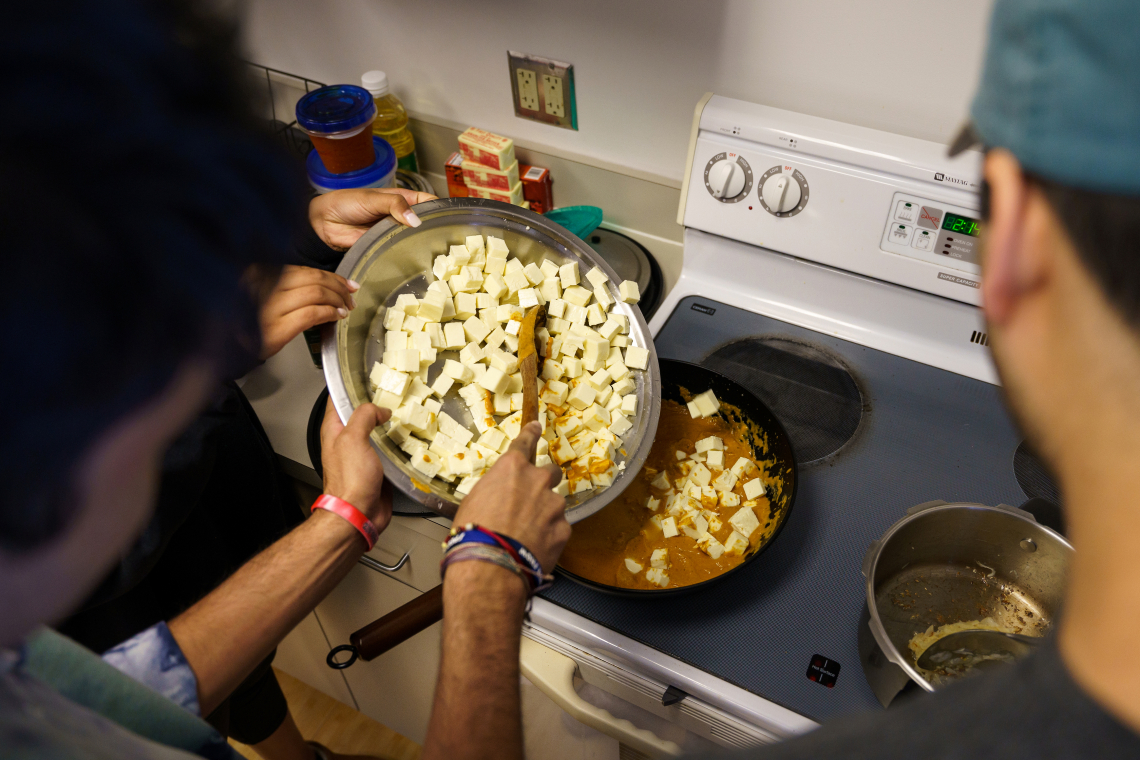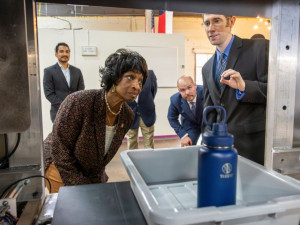Cultural Connections, One Meal at a Time

“Don’t burn the onions.”
From the faculty kitchen in the John Hope Franklin Center, the sounds of determined chopping and intermittent laughter mixed with the intoxicating aromas of cardamom, coriander, fennel and cumin escape down the hallway.
In the middle of the bustle stands Kusum Knapczyk, Hindi lecturer in the Department of Asian and Middle Eastern Studies (AMES). As she checks each student’s progress, she also provides encouragement and instructions in Hindi — or in English for urgent matters.
The 15 quasi sous-chefs are also her intermediate Hindi students. On the menu: a mixed vegetable dish called paneer makhani; roti, a type of Indian flat bread; the yogurt-based side dish cucumber raita; and ginger chai.
In less than two hours, Knapczyk will repeat the painstaking process with her 21 elementary Hindi students, focusing on a different menu that includes the famous Mumbai-based street food called pav bhaji.
While each meal is part of a class celebration of Diwali, one of India’s major festivals, the culinary preparations are also meant to provide the students with a richer understanding of the country.
The language-culture connection
Since her arrival at Duke in 2016, Knapczyk has intentionally added a unit on cooking — including a group hands-on meal preparation — in her Hindi language courses, as a way for students to not only learn the language but also the culture and history of India.
She believes that along with conjugating verbs and memorizing vocabulary, students gain a truly holistic understanding of a country when they are also introduced to its customs, cultures and history.
“Students need to understand the world if they are going to be active, global citizens,” Knapczyk explains. “They can’t stay in their own cocoons.”
Busy prepping the potatoes, Biology major Anushka Goel agrees.
“Studying a language is definitely about learning the mechanics, but it’s also about discovering new ways of thinking and seeing the world,” she says.
“I feel grateful to be able to switch between two languages, two cultures and two ways of perceiving and communicating about the world.”
The prep work
Two weeks prior to entering the kitchen, the students learn both food-related vocabulary and the processes needed for preparing each component of the communal meal. As a group, they decide the menu, watch cooking videos, discuss the ingredient lists and assign kitchen duties — all in Hindi.
Future software engineer One Chowdhury, who is a double major in Computer Science and Statistics, noticed a definite improvement in his vocabulary retention.
“Part of our assignments included writing the cooking steps and explaining how we would cook each item,” he says.
“Because we had to learn the names of the ingredients, the cooking utensils and the processes, I ended up learning a lot of Hindi vocabulary in just one session.”
The cuisine-culture connection
Food is a common denominator, a daily requirement that all humans need for survival. Knapczyk believes that it can also help students when navigating a culture.
She explains that when her students experience India’s cuisine in class, they learn about its people, geography and customs.
Knapczyk finds that in America, most students are only familiar with Punjabi dishes: chana masala, tandoori chicken and saag paneer. For her, this doesn’t give a full picture of what people in India eat every day.
“When students visit India for the first time, they see that every state in the country has its own way of preparing, cooking and eating food,” she says. “This diversity is one of India’s treasures.”
Learning about India’s traditional foods and cooking styles also helped Chowdhury gain an understanding for the country’s geography and culture.
“I realized that India’s cooking has a lot to do with its local resources, which can speak to the diversity and complexities of region-based dishes.”
He points out that in the north of the country there are heavier cream-based dishes, while fish-based cuisines are predominant in the east. And in the south, rice is popular in vegetarian cooking.
“I understand that what people eat reveals a lot about their culture and society, thanks to this exercise.”
Building community in the kitchen
While food teaches students about a country’s culture, it also has the potential to connect them on a more personal level outside of the classroom. Knapczyk hopes that through the acts of preparing and sharing a meal, her students will learn more about each other.
“Along with what they’ve learned in the classroom and the hands-on life lessons of how to cook for themselves, I want the students to experience a sense of community,” she says. “They’re taking the time and care to physically create something meant to be shared with others.”
She knows that some of the students will eventually forget the grammar lessons but hopes they remember cooking and creating memories with their friends — which is equally important.
Back in the kitchen, Knapczyk effortlessly demonstrates how the roti dough needs to be rolled so she can properly cook it on the griddle. As students pat out roundish patties, talk turns to memories of their own family celebrations — and secrets are revealed.
“My family has always soaked the paneer cubes in salt water first.”
“Well, my mom prefers to apply ghee to each roti.”
The conversation quickly turns to a serious group discussion over what size the carrots should be chopped, when Satendra Khanna, an associate professor in AMES, peeks around the doorway and quietly observes the production with wonder.
“I was drawn in by the aromas and the laughter."






